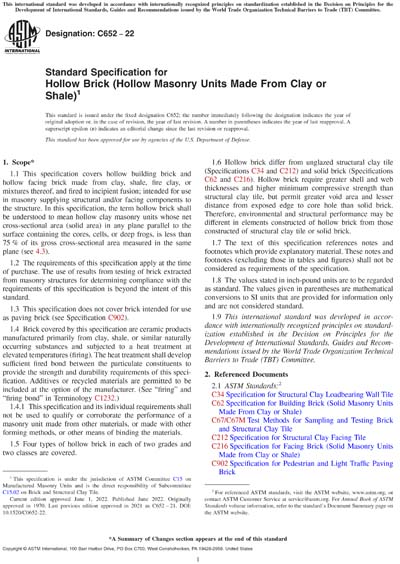Most recent
ASTM C652-22
Standard Specification for Hollow Brick (Hollow Masonry Units Made From Clay or Shale)
1.1This specification covers hollow building brick and hollow facing brick made from clay, shale, fire clay, or mixtures thereof, and fired to incipient fusion; intended for use in masonry supplying structural and/or facing components to the structure. In this specification, the term hollow brick shall be understood to mean hollow clay masonry units whose net cross-sectional area (solid area) in any plane parallel to the surface containing the cores, cells, or deep frogs, is less than 75 % of its gross cross-sectional area measured in the same plane (see 4.3).
1.2The requirements of this specification apply at the time of purchase. The use of results from testing of brick extracted from masonry structures for determining compliance with the requirements of this specification is beyond the intent of this standard.
1.3This specification does not cover brick intended for use as paving brick (see Specification C902).
1.4Brick covered by this specification are ceramic products manufactured primarily from clay, shale, or similar naturally occurring substances and subjected to a heat treatment at elevated temperatures (firing). The heat treatment shall develop sufficient fired bond between the particulate constituents to provide the strength and durability requirements of this specification. Additives or recycled materials are permitted to be included at the option of the manufacturer. (See "firing" and "firing bond" in Terminology C1232.)
1.4.1This specification and its individual requirements shall not be used to qualify or corroborate the performance of a masonry unit made from other materials, or made with other forming methods, or other means of binding the materials.
1.5Four types of hollow brick in each of two grades and two classes are covered.
1.6Hollow brick differ from unglazed structural clay tile (Specifications C34 and C212) and solid brick (Specifications C62 and C216). Hollow brick require greater shell and web thicknesses and higher minimum compressive strength than structural clay tile, but permit greater void area and lesser distance from exposed edge to core hole than solid brick. Therefore, environmental and structural performance may be different in elements constructed of hollow brick from those constructed of structural clay tile or solid brick.
1.7The text of this specification references notes and footnotes which provide explanatory material. These notes and footnotes (excluding those in tables and figures) shall not be considered as requirements of the specification.
1.8The values stated in inch-pound units are to be regarded as standard. The values given in parentheses are mathematical conversions to SI units that are provided for information only and are not considered standard.
1.9This international standard was developed in accordance with internationally recognized principles on standardization established in the Decision on Principles for the Development of International Standards, Guides and Recommendations issued by the World Trade Organization Technical Barriers to Trade (TBT) Committee.
Content Provider
ASTM International [astm]






